Ballistic Composites Market Size
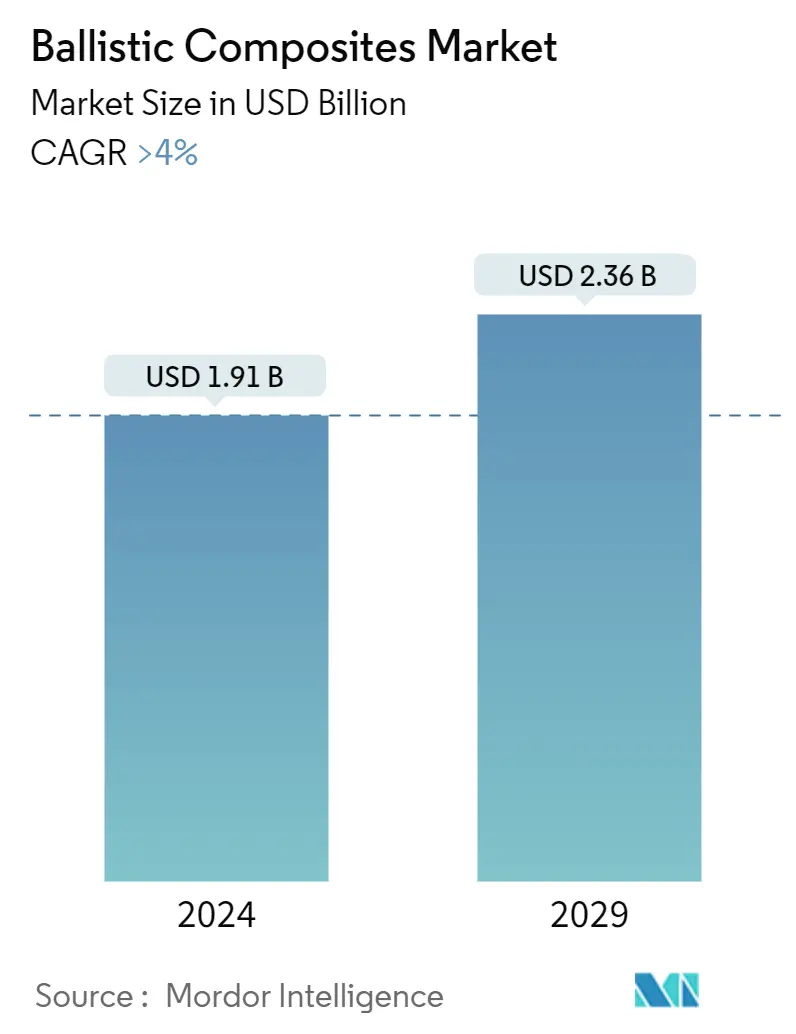
| Study Period | 2019-2029 |
| Market Size (2024) | USD 1.91 Billion |
| Market Size (2029) | USD 2.36 Billion |
| CAGR (2024 - 2029) | 4.00 % |
| Fastest Growing Market | North America |
| Largest Market | North America |
Major Players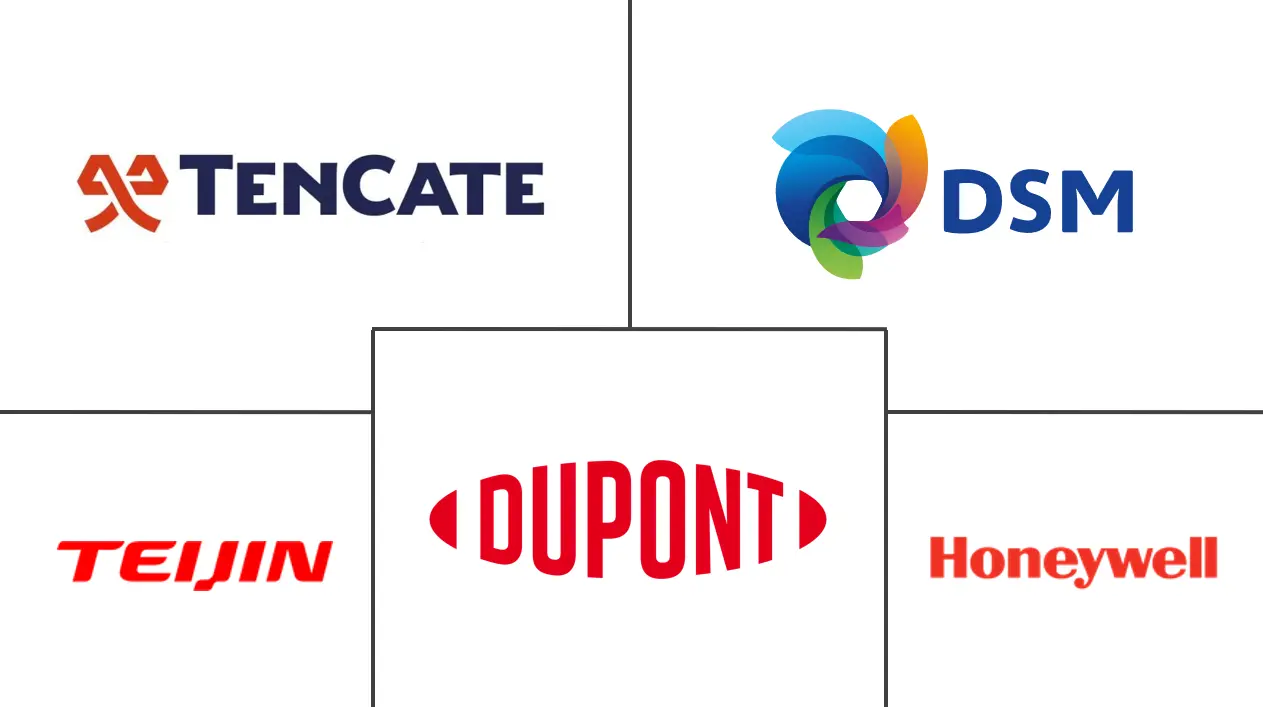
*Disclaimer: Major Players sorted in no particular order |
Ballistic Composites Market Analysis
The Ballistic Composites Market size is estimated at USD 1.91 billion in 2024, and is expected to reach USD 2.36 billion by 2029, growing at a CAGR of greater than 4% during the forecast period (2024-2029).
The COVID-19 pandemic was a mixed bag for the Ballistic Composites Market. While it presented challenges due to supply chain disruptions, demand fluctuations, and economic uncertainty, it also spurred innovation, highlighted new opportunities in security and sustainability, and potentially accelerated the adoption of beneficial technologies in manufacturing. The long-term impact of the pandemic is evident, but the market's adaptability and the ongoing need for high-performance protection materials suggest a promising future.
- One of the major factors driving the market is the increasing demand from the defense and aerospace industries, as modern warfare emphasizes lightweight and comfortable body armor that provides adequate ballistic protection without compromising mobility.
- On the flip side, the processing and manufacturing of ballistic composites often involve complex and labor-intensive techniques. It drove up the costs and may act as a hindrance to the growth of the market studied.
- The rise in defense expenditures and budgets of many countries and the demand for lightweight materials for protection against ballistic threats are likely to act as opportunities in the forecast period.
- North America dominated the market across the world, with the most significant consumption from countries such as the United States and Canada.
Ballistic Composites Market Trends
Increasing Demand for Vehicle Armors
- The demand for vehicle armor in the ballistic composites market is definitely on the rise. It is driven by a multitude of factors, such as growing security concerns, technological advancements, expanding applications, and many more.
- Armored personnel carriers, combat vehicles, and even some military trucks are increasingly utilizing ballistic composites for protection.
- Land combat vehicles are protected by armor sufficient to withstand heavy machinegun fire and overhead artillery fire. These vehicles include external armor kits, which include glass fiber-reinforced support plates. A strengthened undercarriage protects the personnel inside from mines. Exterior armor design generally includes modular expandable armor system panels made with ceramic-faced woven aramid. The roof interiors consist of molded-woven aramid reinforced composites, and the interior sides contain molded, S-fiberglass-reinforced composites.
- Armor protection against ground fire from small arms is also required on the bottom of helicopters. As the fuselage of helicopters needs to be light, the base portion is generally vulnerable to small-arms fire from the ground. It puts the occupants at risk. Lightweight armor for the bottom of helicopters is in use for many years.
- Increasing warfare across the world is increasing the demand for military vehicles required in warships, which is likely to increase the demand for vehicle armor during the forecast period.
- Increased defense spending and security budgets are leading to more significant investment in armored vehicles and advanced armor technologies.
- China's defense industry is increasing, with many Chinese firms displacing Western defense powerhouses. The country invests heavily to upgrade its military, thus making its eight defense firms among the top 25 in the world.
- Currently, the annual output of Chinese military aircraft is around 300. As China's military industry continues to grow, the demand for and supply of Chinese military aircraft will increase substantially. It will drive the rapid development of China's military aircraft manufacturing industry.
- In June 2021, Indonesia unveiled another plan to spend USD 125 billion through the mid-2040s to upgrade and modernize its military arsenal. The total period runs through a period of five strategic plans, each lasting five years. The first strategic plan runs from 2020 to 2024 and coincides with the final phase of the Minimum Essential Force (MEF) program. The document proposes funding of USD 79 billion for defense equipment during these 25 years, USD 32.5 billion for sustainment, and the remaining USD 13.4 billion for interest payments on foreign loans.
- In Japan, an increase in defense expenditure, rising procurement of next-generation weapons, and adoption of advanced technologies in military communication drive the growth of the market across Japan. According to the report published by the Stockholm International Peace Research Institute (SIPRI) in 2022, Japan was the tenth largest defense spender in the world, with a defense budget of USD 46 billion. The country approved USD 51.4 billion in defense spending in FY2023.
- Composite materials gradually crept into armor systems for naval vessels and land combat vehicles. They displaced steel, aluminum, and even titanium alloys, partly due to improved ballistic efficiencies similar to the significant advancements in specific strength and stiffness made in structural materials, as well as being lightweight. Composite parts can be part of the primary armor, especially effective against fragmentation, originating from grenades, mortars, artillery, and other explosive devices. Vehicles can use armor laminates of either S-glass or Kevlar fabric.
- In the area of vehicle armor, ballistic composites provided the following benefits: reduced the weight of a vehicle, increased mobility, decreased number of components required to armor, increased fuel efficiency, and increased life of the vehicle.
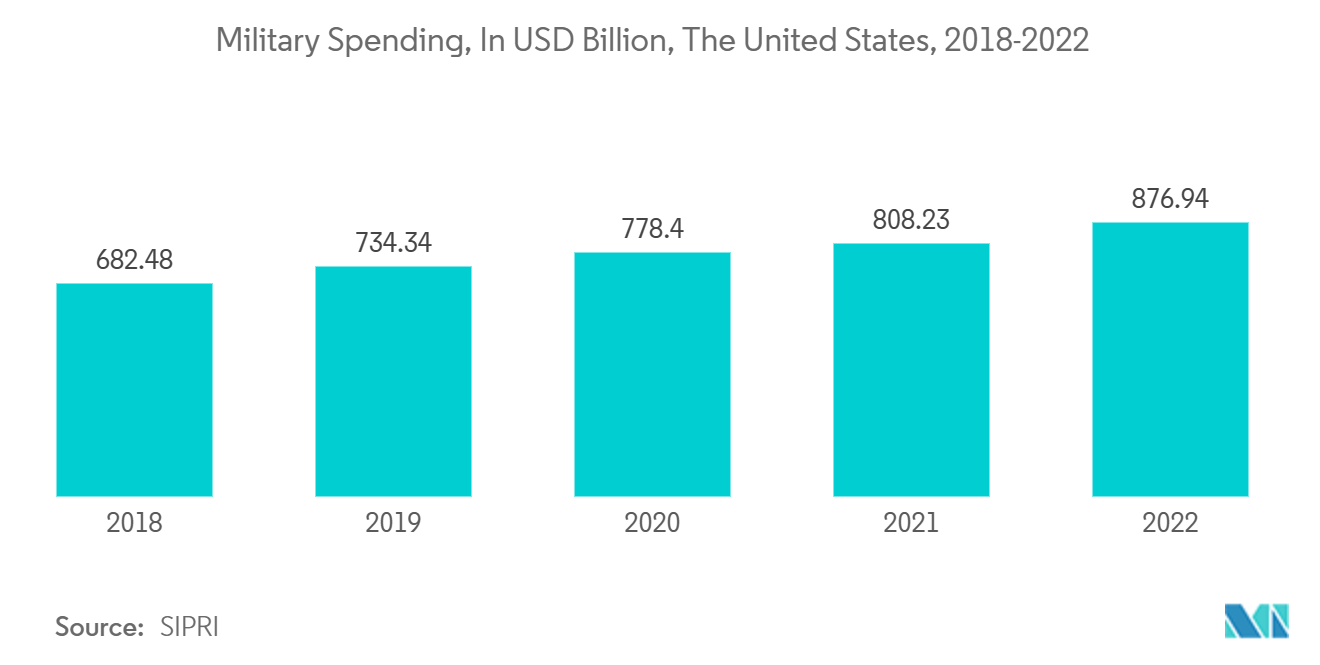
North American Region to Dominate the Market
- The North American region dominated the global market share due to the growing aerospace and defense industrial activities and the increasing need to bring down costs, lower carbon dioxide emissions, and reduce fuel consumption.
- The United States is the largest consumer of the market studied. For FY 2022, the Department of Defense's (DoD) budget authority is approximately USD 722 billion, an increase of USD 17 billion from USD 705 billion in 2020. In comparison, the FY 2023 President's budget request was USD 773 billion for the DoD. The budget primarily aims to modernize capabilities in the air, maritime, and land warfighting domains and to innovate to strengthen the country's competitive advantage.
- By 2023, the Navy forces may increase by 16,900, the Marine Corps by 1,400, and the Air Force by 13,700, increasing the total active-duty military to 1,365,500 personnel.
- The proposal also includes an investment of USD 6.5 billion to place more tanks, armored vehicles, and other combat equipment in Europe as part of the Pentagon plan to reassure European allies.
- As of October 2022, the US Army and BAE Systems are working together to identify ways to accelerate production of the new Armored Multi-Purpose Vehicle, which would let the service more quickly replace aging M113 armored troop carriers.
- According to the Congressional Research Service, the AMPV(Armored Multi-Purpose Vehicle) annual production rate reportedly, by FY2024, AMPV production rates are planned to increase to 131 vehicles per year and to continue at that level until at least FY2027. Earlier AMPV program planning documents issued before the 2020 production delay had reportedly called for an annual production rate of 190 AMPVs per year by FY2024.
- The country's defense agencies are on a spree of procurements in view of the Russia-Ukraine war that drove significant US weapon supply to Ukraine. To successfully tackle any Russian threat, the Air Force is carrying out growth in procurement. For instance:
- Recently, in March 2022, the Pentagon requested a USD 11 billion fund for 61 Lockheed Martin F-35 Lightning II aircraft for FY2023. About 45% of that procurement plan is for combat aircraft (USD 8.389 billion) and 23% for modifying in-service platforms (USD 4.257 billion).
- Owing to the factors above, the ballistic composites market in the region is expected to increase at a significant rate during the forecast period.
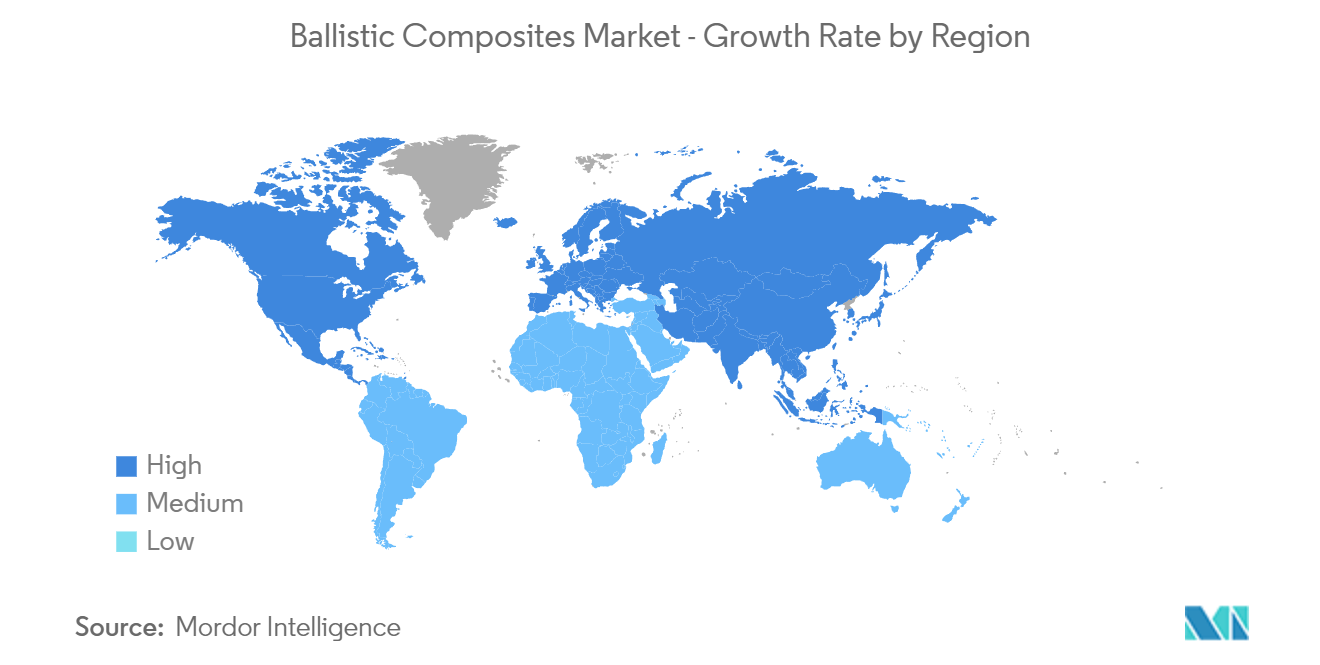
Ballistic Composites Industry Overview
The ballistic composites market is partially consolidated in nature. The major players (not in any particular order) include DuPont, DSM, Honeywell International Inc., TenCate Protective Fibers, and Teijin Limited, among others.
Ballistic Composites Market Leaders
-
DSM
-
DuPont
-
Teijin Limited
-
Honeywell International Inc.
-
TenCate Protective Fabrics
*Disclaimer: Major Players sorted in no particular order
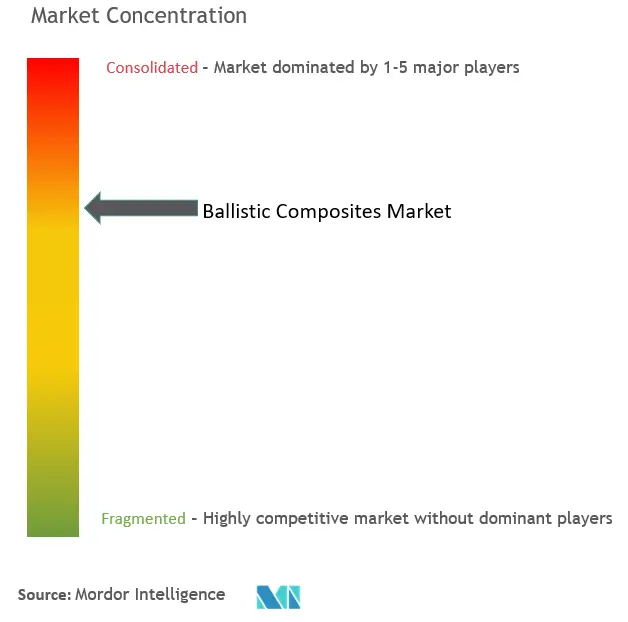
Ballistic Composites Market News
- November 2023: Integris Composites developed a new system of ballistic vest gear for law enforcement and military units and launched the company’s new Rapid Don/Doff body armor vests. It is an equipment that dramatically reduces the time for donning and doffing one’s body armor rig—by 50% or more.
- November 2023: Integris Composites launched customizable ballistic shields and vests, "Stand 5 F009", at Milipol Paris and displayed this product as a "make your own shield." concept.
Ballistic Composites Market Report - Table of Contents
1. INTRODUCTION
- 1.1 Study Deliverables
- 1.2 Study Assumptions
- 1.3 Scope of the Study
2. RESEARCH METHODOLOGY
3. EXECUTIVE SUMMARY
4. MARKET DYNAMICS
-
4.1 Drivers
- 4.1.1 Rise in Defense Expenditure
- 4.1.2 Increasing Demand for Lightweight Materials in the Aerospace and Defense Industry
- 4.1.3 Other Drivers
-
4.2 Restraints
- 4.2.1 High Processing and Manufacturing Costs
- 4.2.2 Volatile Raw Material Supply
- 4.3 Industry Value Chain Analysis
-
4.4 Porter's Five Forces Analysis
- 4.4.1 Bargaining Power of Suppliers
- 4.4.2 Bargaining Power of Buyers
- 4.4.3 Threat of New Entrants
- 4.4.4 Threat of Substitute Products and Services
- 4.4.5 Degree of Competition
5. MARKET SEGMENTATION (Market Size In Value)
-
5.1 Fiber Type
- 5.1.1 Aramids
- 5.1.2 Ultra-high-molecular Weight Polyethylene (UHMWPE)
- 5.1.3 S-glass
- 5.1.4 Others Fiber Types (Bio-based Fibers, Nanocomposites, etc. )
-
5.2 Matrix Type
- 5.2.1 Polymer
- 5.2.2 Polymer-ceramic
- 5.2.3 Metal
-
5.3 Application
- 5.3.1 Vehicle Armor
- 5.3.2 Body Armor
- 5.3.3 Helmet and Face Protection
- 5.3.4 Other Applications (Aircraft and Marine Protection, High-Performance Sporting Goods, etc.)
-
5.4 Geography
- 5.4.1 Asia-Pacific
- 5.4.1.1 China
- 5.4.1.2 India
- 5.4.1.3 Japan
- 5.4.1.4 South Korea
- 5.4.1.5 Rest of Asia-Pacific
- 5.4.2 North America
- 5.4.2.1 United States
- 5.4.2.2 Canada
- 5.4.2.3 Mexico
- 5.4.3 Europe
- 5.4.3.1 Germany
- 5.4.3.2 United Kingdom
- 5.4.3.3 Italy
- 5.4.3.4 France
- 5.4.3.5 Spain
- 5.4.3.6 Rest of Europe
- 5.4.4 South America
- 5.4.4.1 Brazil
- 5.4.4.2 Argentina
- 5.4.4.3 Rest of South America
- 5.4.5 Middle-East and Africa
- 5.4.5.1 Saudi Arabia
- 5.4.5.2 South Africa
- 5.4.5.3 Rest of Middle-East and Africa
6. COMPETITIVE LANDSCAPE
- 6.1 Mergers and Acquisitions, Joint Ventures, Collaborations, and Agreements
- 6.2 Market Share (%)**/Ranking Analysis
- 6.3 Strategies Adopted by Leading Players
-
6.4 Company Profiles
- 6.4.1 ArmorCore
- 6.4.2 BAE Systems
- 6.4.3 Barrday Inc
- 6.4.4 Coherent Corp.
- 6.4.5 DSM
- 6.4.6 DuPont
- 6.4.7 Gaffco Ballistics
- 6.4.8 Gurit Holding AG
- 6.4.9 Honeywell International Inc.
- 6.4.10 Integris
- 6.4.11 MKU LIMITED
- 6.4.12 Morgan Advanced Materials
- 6.4.13 Plastic Reinforcement Fabrics Ltd
- 6.4.14 Roihu Inc.
- 6.4.15 Southern States, llc
- 6.4.16 Teijin Limited
- 6.4.17 TenCate Protective Fabrics
- *List Not Exhaustive
7. MARKET OPPORTUNITIES AND FUTURE TRENDS
- 7.1 Development of Terrain Motor Vehicles with Ballistic Protection
- 7.2 Development of Bio-Based Ballistic Fibers
Ballistic Composites Industry Segmentation
Ballistic composites are high-performance fibers capable of absorbing shock and impact energy caused by explosions. They consist of layered structural composites with polymer matrix reinforced with glass, carbon, and para-aramid fibers to provide enhanced strength and stiffness. These composites are commonly used as raw materials to manufacture vests, helmets, shields, and body and vehicle armor. They exhibit various advantageous properties, such as resistance to heat and corrosion, high thermal conductivity, and durability. As a result, they find extensive applications across various industries, such as defense, automotive, aviation, and aerospace.
The ballistic composites market is segmented by fiber type, matrix type, application, and geography. By fiber type, the market is segmented into aramids, ultra-high-molecular-weight polyethylene (UHMWPE), S-glass, and other fiber types (bio-based fibers, nanocomposites, etc.). By matric type, the market is segmented into polymer, polymer-ceramic, and metal. By application, the market is segmented into vehicle armor, body armor, helmet, and face protection, and other applications (aircraft and marine protection, high-performance sporting goods, etc.). The report also covers the market size and forecasts for the ballistic composites market for 16 major countries across the major region. For each segment, the market sizing and forecasts are done on the basis of value (USD).
| Fiber Type | Aramids | |
| Ultra-high-molecular Weight Polyethylene (UHMWPE) | ||
| S-glass | ||
| Others Fiber Types (Bio-based Fibers, Nanocomposites, etc. ) | ||
| Matrix Type | Polymer | |
| Polymer-ceramic | ||
| Metal | ||
| Application | Vehicle Armor | |
| Body Armor | ||
| Helmet and Face Protection | ||
| Other Applications (Aircraft and Marine Protection, High-Performance Sporting Goods, etc.) | ||
| Geography | Asia-Pacific | China |
| India | ||
| Japan | ||
| South Korea | ||
| Rest of Asia-Pacific | ||
| Geography | North America | United States |
| Canada | ||
| Mexico | ||
| Geography | Europe | Germany |
| United Kingdom | ||
| Italy | ||
| France | ||
| Spain | ||
| Rest of Europe | ||
| Geography | South America | Brazil |
| Argentina | ||
| Rest of South America | ||
| Geography | Middle-East and Africa | Saudi Arabia |
| South Africa | ||
| Rest of Middle-East and Africa |
Ballistic Composites Market Research FAQs
How big is the Ballistic Composites Market?
The Ballistic Composites Market size is expected to reach USD 1.91 billion in 2024 and grow at a CAGR of greater than 4% to reach USD 2.36 billion by 2029.
What is the current Ballistic Composites Market size?
In 2024, the Ballistic Composites Market size is expected to reach USD 1.91 billion.
Who are the key players in Ballistic Composites Market?
DSM, DuPont, Teijin Limited, Honeywell International Inc. and TenCate Protective Fabrics are the major companies operating in the Ballistic Composites Market.
Which is the fastest growing region in Ballistic Composites Market?
North America is estimated to grow at the highest CAGR over the forecast period (2024-2029).
Which region has the biggest share in Ballistic Composites Market?
In 2024, the North America accounts for the largest market share in Ballistic Composites Market.
What years does this Ballistic Composites Market cover, and what was the market size in 2023?
In 2023, the Ballistic Composites Market size was estimated at USD 1.83 billion. The report covers the Ballistic Composites Market historical market size for years: 2019, 2020, 2021, 2022 and 2023. The report also forecasts the Ballistic Composites Market size for years: 2024, 2025, 2026, 2027, 2028 and 2029.
Ballistic Composites Industry Report
Statistics for the 2024 Ballistic Composites market share, size and revenue growth rate, created by Mordor Intelligence™ Industry Reports. Ballistic Composites analysis includes a market forecast outlook to 2029 and historical overview. Get a sample of this industry analysis as a free report PDF download.



